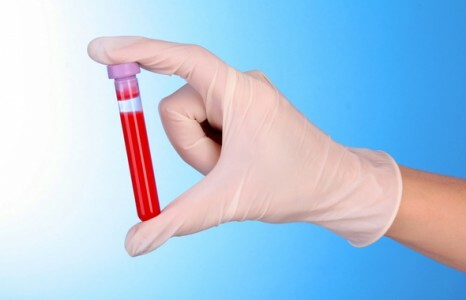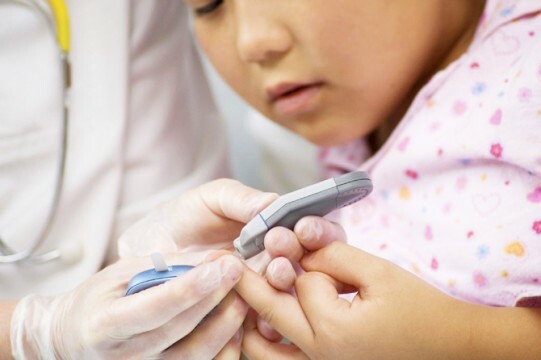Prolactin is a female sex hormone responsible for the maturation of mammary glands in girls and for lactation in adult women. It is synthesized in lactogenic cells located in the anterior pituitary gland and its release is controlled by the pituitary gland. This hormone is present in the blood in several forms - monomeric, consisting of one peptide chain and showing the main biological activity;dimeric and tetrameric, biologically inactive or having low activity. To assess the concentration of prolactin in the blood, only the concentration of the monomeric form is important, since only it is biologically active. In men, prolactin is also produced, but its purpose is unknown.
Norm and regulation of

The synthesis and secretion of prolactin in the pituitary gland is controlled by several centers in the hypothalamus. Stimulate the secretion of melatonin and serotonin, exercise, sleep, pregnancy and hypoglycemia, oppress - the effects of adrenaline, norepinephrine, acetylcholine and GABA.The mammary gland, which is the target organ for prolactin, under its action begins to produce and release milk, this is justified lactation after childbirth. A girl during puberty prolactin determines the development of mammary glands.
The norm of prolactin in the blood is 4.5-49 ng / ml in women, depending on the phase of the menstrual cycle, in men - 2.5-17 ng / ml. The level of prolactin can be slightly increased after stress, in the early morning hours, within a year or two after childbirth or abortion.
Causes and symptoms of increased prolactin
Normally, a high prolactin content occurs in the last weeks of pregnancy and after childbirth, in other cases, its high level indicates a pathology. The most common cause, due to which there is increased prolactin in both men and women - adenoma( a tumor consisting of cells of the glandular tissue) of the pituitary gland, which releases an excessive amount of the hormone. It also stimulates the secretion of prolactin excess weight, endocrine diseases, liver and kidney disease, taking some drugs - dopamine, in women - taking oral contraceptives. Injuries, surgeries and irradiation of the pituitary gland and mammary glands promote the development of hyperprolactinemia.
Symptoms of hyperprolactinemia in women:
- Scarce menstruation or their complete cessation.
- Galactorrhea is the expiration of milk from the breast glands of a non-burdensome woman. It is easy - if the milk is released only by small drops when pressing on the nipple, the average severity level - the discharge of milk with trickles when pressed, and heavy - the milk stands out by itself, without affecting the nipple.
- Decreased sex drive.
- Hair growth on the body - along the white line of the abdomen, on the face.
- Acne vulgaris.
- Weight gain.
In men, hyperprolactinemia is manifested by gynecomastia( formation of mammary glands similar to females), a decrease or lack of potency, a decrease in body hair growth.
Elevated levels of prolactin are not only a laboratory indicator, hyperprolactinemia has serious consequences. Women with a high level of prolactin outside of pregnancy can not bear and give birth to a child - they develop anovulatory cycles( no ovulation while maintaining menstruation), making it impossible to conceive, miscarriages occur in the early stages of pregnancy( if such episodes are repeated more than twice in a row, this condition is calledhabitual miscarriage).In addition, galactorrhea, especially severe, can become a significant problem.
In men, the excess of prolactin also leads to impotence and infertility, and gynecomastia and obesity "by the female type" can affect not only the appearance, but also the relationships with others.
Low prolactin level
Normally, the level of prolactin is lower in men and boys, girls before puberty, may be low in non-pregnant women, girls who do not live sexually, in the early stages of pregnancy.
A small amount of prolactin in late pregnancy and after childbirth makes breastfeeding impossible, its cause can be a serious pathology of the pituitary or hypothalamus( tumor, the consequences of radiation or chemotherapy, tuberculosis or syphilitic damage).This condition requires additional examination and treatment.
Determination of prolactin in the blood

To determine the amount of prolactin in the blood, the enzyme immunoassay( ELISA) method is used, based on the use of several different test systems containing antibodies to prolactin. The essence of the method is that the hormone binds to antibodies, forming antigen-antibody complexes, and then precipitation occurs or other visible changes in the solution( depending on the test system used), after which it becomes possible to quantify the antigen-antibody complexes. In test systems, animal antibodies are used, usually mouse, and dyes or other substances that allow you to visually determine the presence of a reaction.
But since only monomeric prolactin is biologically active, at high concentrations of the hormone for a more informative, a PEG-precipitation test is carried out. PEG-6000 is a solution of polyethylene glycol, which processes a blood sample before making a repeat analysis for prolactin. In this case, the monomeric form of prolactin is precipitated, so the discrepancy between the initial and the post-PEG sample shows the presence of dimeric and tetrameric forms of prolactin, as well as a complex of prolactin with immunoglobulin( macroprolactin).The true concentration of prolactin is determined by the concentration ratio in the initial sample and the post-PEG.If this ratio is 60% or more, then the prolactin contained in the blood is monomeric, biologically active, if less than 40% - on the contrary, most of the prolactin is biologically inactive, a 40-60% interval is called the gray zone, when repeated analysis of prolactin after severaldays.
In addition to laboratory tests, there are also express tests that give only an approximate estimate of the amount of prolactin, but allow us to conclude when it is elevated. These tests also use mouse antibodies and two color indicators, one changes color with an increased level of prolactin and remains unchanged with its normal content, the other shows the reactivity of the test components, and changes color in any case.
Preparing for analysis of
In order for the results of the analysis to be most informative, you need:
- When assigning the analysis:
- Women are taken into consideration on which day of the cycle the analysis will be submitted. The ideal time is 3-8 days, during pregnancy you can take it on any day;
- In men, the time of delivery of the analysis does not matter.
- Two to three days before the analysis:
- Abstain from sexual activity;
- Reduce the intensity of physical exertion;
- Limit the amount of sweet food;
- Avoid stress when possible;
- To exclude any effects on the mammary glands( including examination with a gynecologist or mammologist, they should be postponed for a while after the analysis).
- On the day of analysis:
- Blood donation in the morning, from 9 to 12;
- Wake up at least two hours before the test, because during sleep, the level of prolactin is increased.
Treatment of hyperprolactinemia
The basis of medicamental treatment of hyperprolactinemia is ergot preparations( parlodel, abergin).They reduce the production of prolactin in the pituitary cells, and also have the ability to reduce the size of the pituitary adenoma. Reception of parlodel is possible in women up to three years, in men - according to indications. The use of these drugs in the early stages of pregnancy is possible under the supervision of a gynecologist, often due to ergot preparations, pregnancy in general becomes possible. It should be noted that if the adenoma responds well to treatment, then pregnancy can occur quickly enough. In later terms, it is recommended to stop taking parlodel so that the concentration of prolactin returns to the norm of the last weeks of pregnancy and after birth a normal lactation developed. Taking oral contraceptives or installing an intrauterine device on the background of the parlodel and its analogues is not recommended( if a spiral was installed, it is better to remove it).The method of contraception in this case should be discussed with a gynecologist.
The indication for surgical treatment of adenoma of the pituitary gland in women is the large size of the adenoma, its rapid growth, when an increase in the pituitary gland can cause not only an excess of prolactin, but also visual impairment( loss of external fields of vision, then complete blindness), as over the Turkish saddle, where the pituitary gland is located, is the intersection of the optic nerves. A small and slowly growing or not growing adenoma is not operated because of the high risks of brain surgery. In men, the adenoma of the pituitary gland almost always grows rapidly and reaches a large size, and therefore almost always requires surgical treatment.
Sometimes, with low sensitivity of adenoma to medical treatment and the impossibility of surgical removal, radiation therapy is used.
There are no specific prophylaxis measures for hyperprolactinemia. In order not to cause a hormonal failure, it is necessary to take with caution oral contraceptives - only according to the doctor's prescription, do not abuse sun exposure, because sunlight stimulates the hypothalamus and the pituitary gland. When there is excretion from the breast, you do not need to squeeze them out - this increases the sensitivity of the gland tissue to prolactin. The allocation of small quantities of milk before delivery, after abortion, in some women - during menstruation, is considered the norm.



